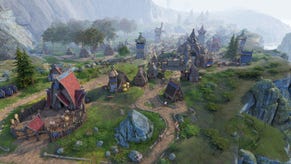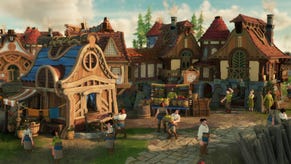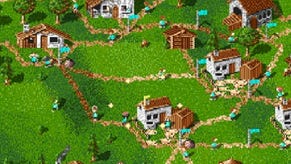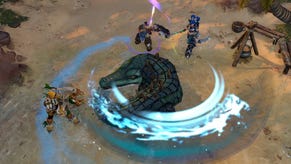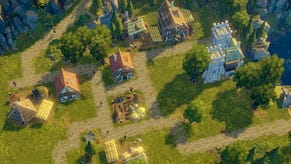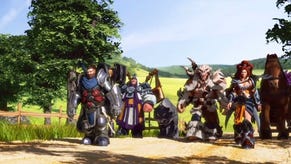The Settlers has finally emerged from development hell, and it's fighting fit
We've been hands on with the upcoming closed beta ahead of its release in March
It's been over a decade since a core game in The Settlers series last made landfall on PC, and during that time the real-time management landscape has arguably changed quite a bit. There have been some great building games that have risen up, and even developer Blue Byte (now Ubisoft Dusseldorf)'s own Anno series has staked a powerful claim to the city-building throne. But this incarnation of The Settlers isn't so much about connecting to the series' past as it is about laying down foundations for the future. It's had a slightly rocky road to launch, suffering several delays and refunded pre-orders after being postponed indefinitely back in 2020, but at long last this reboot of the classic city-building conquest-me-do is finally ready to beat down our door and come barrelling in. It's launching in full on March 17th, and I've been hands on with an early version of the upcoming closed beta build that will be running from January 20th-24th. So settle in, folks. Here's how it's shaping up.
First things first. The raw, beating production heart of The Settlers is very much intact. As in The Settlers games of yore, if you want your blooming township to eat, you're going to have to build a farm to produce the wheat, a windmill to grind that wheat into flour, and then a bakery to pound said flour into delicious loaves of bread. You'll need to do this while also making sure you've got dirt tracks or gravel pathways connecting these buildings to the central warehouse, and enough spare workers and residences to staff each place. The same goes for building up your army for keeping enemies at bay. First you'll need to mine the right materials, build a furnace to smelt that ore into ingots, and a blacksmith to hammer those ingots into individual weapon types.
Indeed, despite being a reboot of the series, creative director Christian Hagedorn told me that this new iteration of The Settlers was still very much inspired by The Settlers 3 and 4. An odd choice, perhaps, given their rather lukewarm receptions back at the turn of the millennium, but as you can imagine, most of the upgrades come from the Office of Improved Visuals. As the new closed beta trailer above takes great pains to point out, The Settlers reboot benefits from beautifully detailed character animations as well as realistic settings and lighting effects, thanks in no small part to Ubisoft's Snowdrop engine - the same engine used to create The Division 2 and Ubisoft's upcoming Avatar game. The settlers themselves are still delightfully cartoonish, but there's a real sense of hustle and bustle going on under your nose here, and occasionally I'd just zoom the camera right in with a flick of my mouse wheel to stare at the little men pushing planks of wood across perpetually whirring buzz saws, or follow the clutch of berry pickers foraging for tasty treats in the bushes.
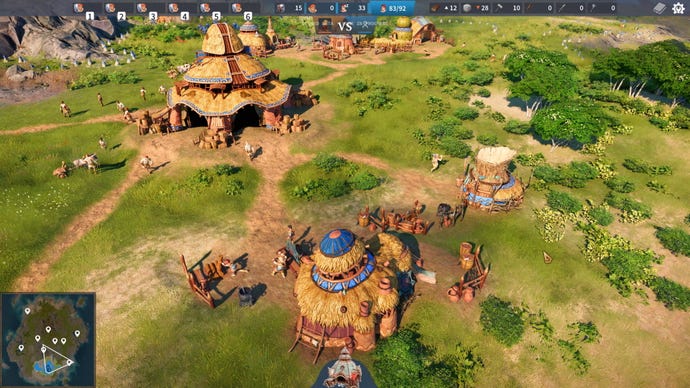
My favourite people to watch, though, are the new Engineers. These chaps and chapesses, easily identified by their eye-catching blue banners sprouting out of their backpacks, are the only civilians you have direct control over outside your combat armies, and they form the backbone of your society. They build what needs building, survey the outer edges of your town to expand your territory, inspect quarries for seams of valuable minerals, and transport wayward goods you can find out and about on the map back to your main camp.

They're busy little bees, especially once you enable the auto-construct option that sends them on to any unfulfilled building projects once they're done with their current one. Watching them rush to and fro, next to a conga line of citizens / donkey carts carrying out all the requisite materials from the nearest warehouse, brings a warm sense of satisfaction to this somewhat lapsed city-building player, and seeing your settlement take shape in such glorious, painstaking detail is really quite something. You'll miss your Engineers when they get offed by a rogue bandit while they're out and about surveying, too. They don't come cheap, as each one needs their own little hammer tool (which requires ore, then ingots and then a separate tool maker building) before you can train another one.

Provided you keep a watchful eye over them, though - and build a wall of arrow-shooting guard towers to protect your outer fringes from unwanted interlopers - you can get a handle on The Settlers. It only took a couple of Skirmish matches against the AI before I settled into the groove of its various production lines. The main game will have a central campaign, a single player challenge mode called Onslaught, and up to 4v4 multiplayer battles via the aforementioned Skirmish mode, but the closed beta build I played limited me to just 1v1 and 2v2 Skirmish matches, either against the AI or other players.

I also only had two of the three playable factions to pick from - the rustic Elari farmers and the sea-loving Maru. The third faction, available in the full game come March time, is the gruff warrior clan Jorn, who would seem to be a little hardier than the Elari and Maru with their sterner-looking buildings and darker faction colours. Technically, they all have their own quirks and disadvantages, such as unique warriors and higher or lower building costs, but from my experience at least the Elari and Maru both felt largely the same.
The rhythm of building up my towns didn't change much from match to match, for example, and the cost of individual buildings is usually so low in the grand scheme of things that requiring a handful less wood or stone here and there never really made much of a dent on my overarching economy. Due to the nature of its production line structure, those individual costs do eventually add up over time, but not to the extent that it took me significantly longer or shorter amounts of time to accomplish per match. I'm sure more competitive players will no doubt root out some super high level strategies once the game launches in full, but for this comparative newcomer, the factions' unique traits never really made themselves apparent.

Not that this detracted from my overall enjoyment, I might add. In the lush green Shire map I was presented with, simply taming the natural landscape and broadening my borders was challenge enough for me. While the main aim was to destroy my opponent's main warehouse - what would normally be your keep or town hall in other city-builders - there were also various landmarks I could seek out for extra rewards and resources. These are another new addition to the series along with the Engineers, and provided some much needed waypoints to help guide my gradual expansion. Some took the form of mysterious ruins or wrecked ships on the beaches, while others were hostile bandit camps and caches of stolen goods. In each case, the reward was definitely worth fighting and exploring for.
The combat units aren't perhaps quite as varied as other conquest-based city-builders out there. You've got your standard soldiers, axe boys and archers, plus healers who can replenish their health bars and provide combat buffs if you pump enough gems into your research tree. There are also two siege units: torch-throwing mercs; and torch-throwing mercs seated on top of what I can only assume is some kind of armoured buffalo. They're great fun, but it seems like this is as exotic as it's going to get for this lot for fighters, which does somewhat disappoint the gryphon rider and giant turtle-loving part of my brain from my early Warcraft 2 days.

Still, I think adding more unit types to the mix would probably send The Settlers' economy plummeting into chaos, as even building up a decent number of these basic fighters required quite a forward planning and investment that took me by surprise. I got lucky in a couple of matches, happening upon a deposit of gems to unlock those all-important healers, but other matches weren't so generous. Fortunately, building a harbour will unlock the ability to trade, allowing you to buy in items you don't have access to otherwise - provided you've got enough coin to pay for them, of course, which you can either get from selling items through the harbour or by finding a gold mine and building your own mint.

Matches are pretty lengthy. Even once I'd got to grips with its various systems, my quickest Skirmish still took me a good two hours to beat the opposing faction into submission, and I'll be interested to see how the campaign missions fare by comparison. According to game director Nadim Affani, the campaign will see players leaving their homes behind in order to settle in a new part of the world. It centres on the Elari, but you'll find and meet each of the other factions along the way. Sometimes they'll be allies, other times they'll be a bit more hostile as you pass through the world's three main biomes. These are the verdant Forgotten Plains, the dry desert in the aptly named Cursed Lands, and the misty Valed Island, but from the sound of things time won't necessarily be of the essence. You'll be able to move at your own pace, and take in the world as you see fit.
Luckily, we won't have to wait too long to find out for sure, as The Settlers will launch in full on March 17th. If you'd like to try the upcoming closed beta running from January 20th-24th for yourself, you can sign up for a chance to play over on The Settlers website.
A group of Ubifolk are still campaigning for management to do more "to end abuse in Ubisoft and the wider industry." While the company vowed to improve following the many allegations of abuse, harassment, and discrimination which emerged in 2020, the group known as ABetterUbisoft feel they've still not done enough. They laid out their demands in August 2021 with an open letter signed by 1000 current and former employees, and followed up with a public petition.



